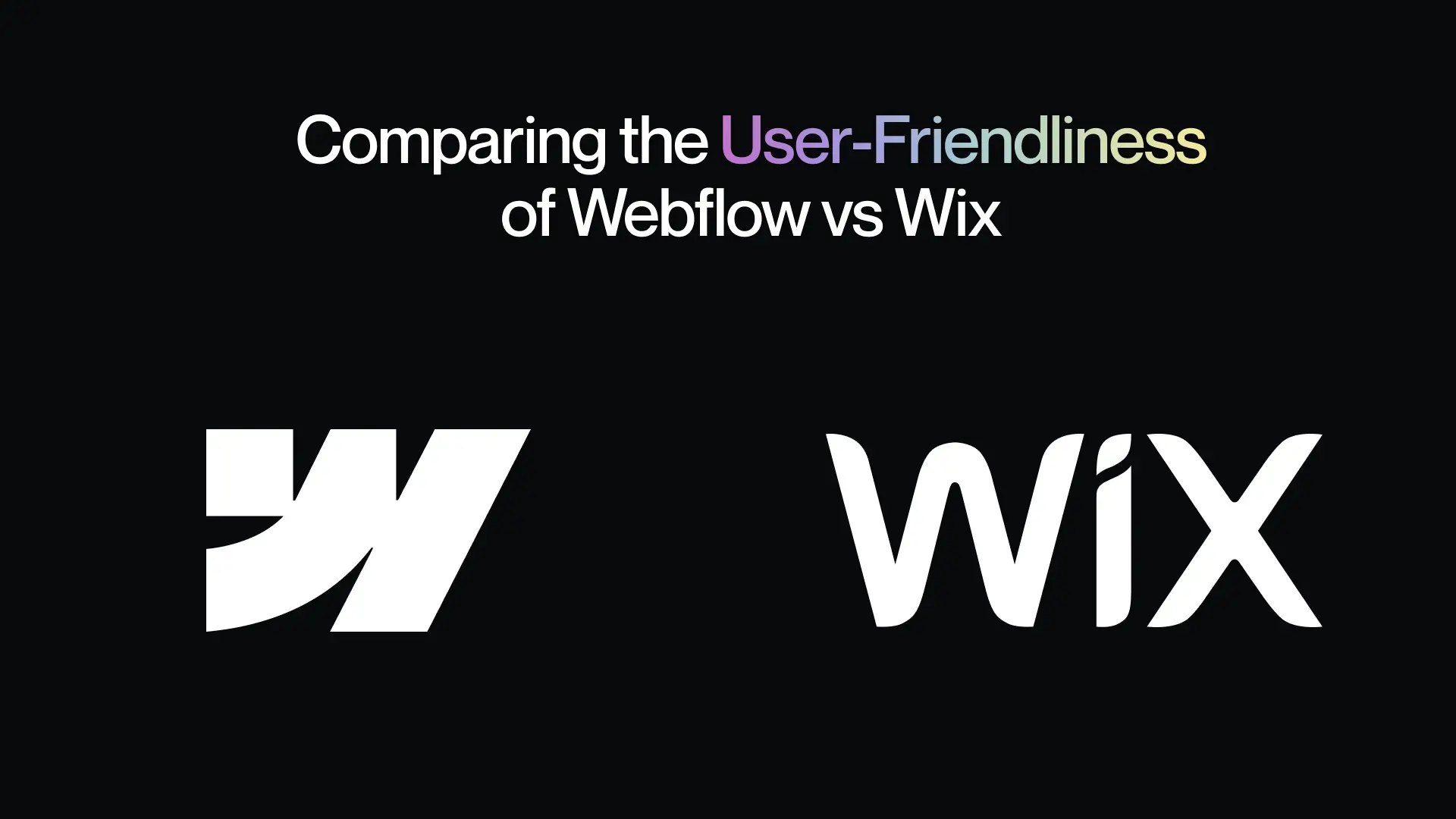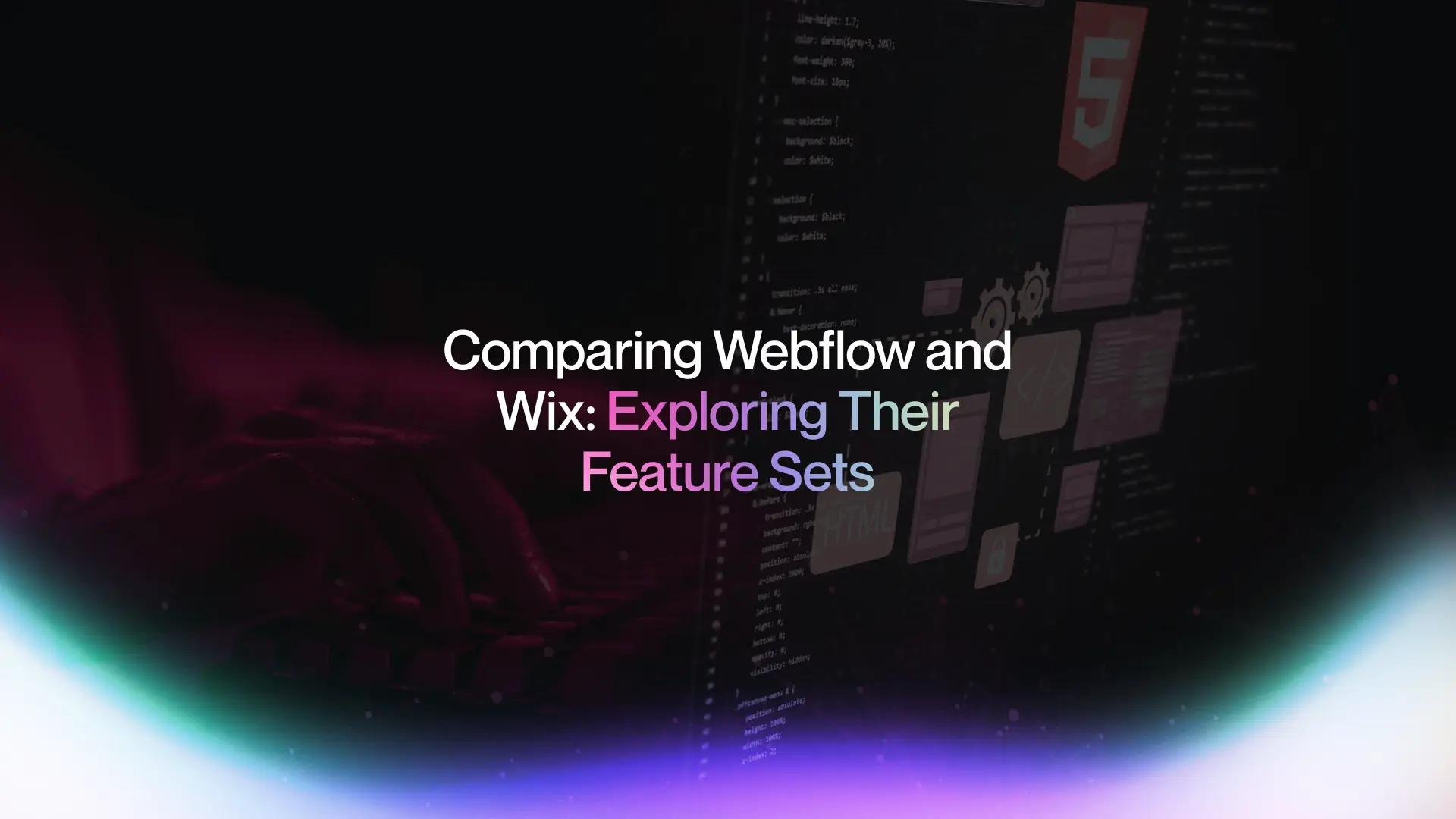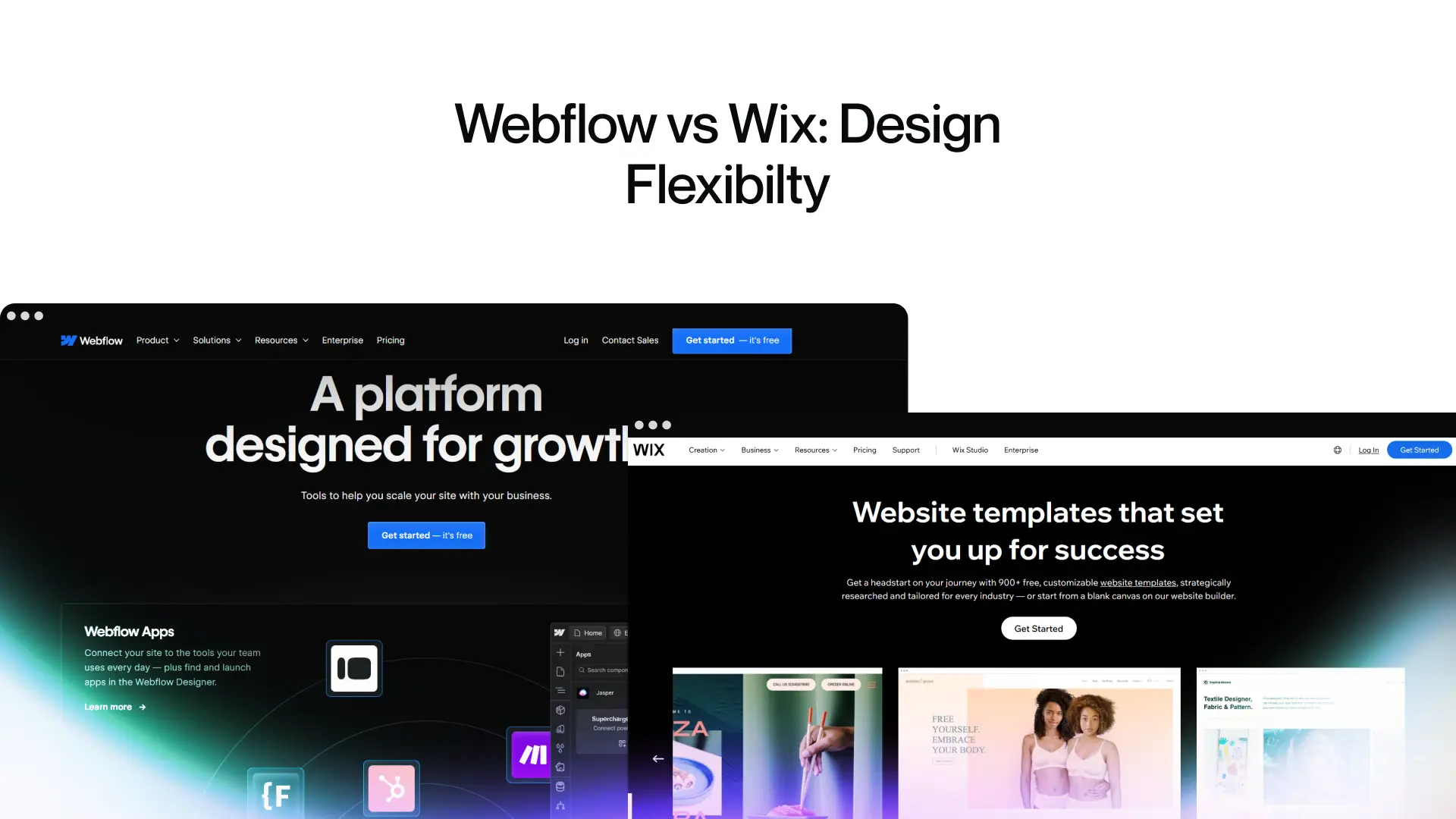Both Webflow and Wix stand as prominent website builders, offering a large range of exceptional features that streamline the entire website development journey with remarkable ease and intuitiveness.
Nonetheless, many designers, developers, and business owners find themselves at a crossroads when it comes to selecting the optimal builder for their needs.
In light of this dilemma, we've conducted a comparison between Webflow vs Wix.
We will delve into various categories, subjecting both tools to a thorough evaluation within each realm.
Ultimately, we will select a victor in this showdown!
Comparing Webflow vs Wix
To understand better how both platforms work, we will go through a quick review of the basic features and characteristics of both Webflow and Wix.
Webflow vs Wix: A Quick Overview
Webflow:
- Employs an HTML and CSS editor, granting advanced customization capabilities.
- It provides complete customization freedom, allowing users to tailor their websites extensively.
- Demands a steeper learning curve to harness its full potential.
- Features Webflow University, renowned for its exceptional explainer videos to aid users in mastering the platform.
Wix:
- Requires no coding expertise, making website creation accessible to everyone.
- Primarily utilizes pre-designed templates, simplifying the design process.
- Wix is known for its user-friendliness, making it an excellent choice for beginners.
- Offers robust customer support to assist users.
Comparing User-Friendliness: Webflow vs. Wix

Let’s go over various facets that play a role in determining their individual degrees of user-friendliness.
Webflow:
Webflow offers a straightforward registration process, enabling quick sign-in via Google or manual registration with an email.
The onboarding procedure begins with a series of questions designed to tailor your user experience.
Once registered, you'll enter Webflow's editor, which might seem a bit overwhelming for newcomers.
Webflow provides an interactive guide to familiarize you with the editor's functions and kickstart your website creation journey.
Webflow can appear to cater more to individuals with design and development experience, but it is not necessary.
While coding isn't mandatory, some knowledge of HTML and CSS enhances your ability to make intricate customizations.
Webflow balances complexity and user-friendliness, making it a preferred choice for professionals seeking to craft exceptional online experiences.
Wix:
Wix too has an intuitive, user-friendly design interface that accommodates individuals from various backgrounds.
While it excels in accessibility, it's important to note that Wix has its share of drawbacks.
Initiating your journey with Wix is indeed straightforward, with a quick and hassle-free registration process taking just a few minutes. However, as you delve deeper, you'll encounter limitations.
For instance, Wix provides specialized templates and customization options for niche-specific websites, but it has some constraints when it comes to advanced customizations and coding flexibility.
This can be a drawback if you have more complex design needs or if you're an experienced developer seeking greater control over your site's functionality.
So, while Wix offers a user-friendly entry point, it's essential to consider its limitations as your website requirements evolve.
Comparing Webflow and Wix: Exploring Their Feature Sets

Webflow:
Webflow offers a comprehensive array of features designed to empower users, allowing them to focus on the business and marketing aspects of their projects while enjoying a seamless design experience.
One of Webflow's standout features is its dedication to producing clean, semantic, and compliant code while you work on your design.
This code, encompassing HTML, CSS, and images, is conveniently packaged into a single ZIP file for versatile usage.
Webflow readily accommodates custom code integration, providing design flexibility.
But Webflow's efficiency extends beyond code quality; it encompasses motion design capabilities as well.
Users can effortlessly create design interactions without the need for coding expertise and explore 3D transforms and animations, enabling cutting-edge and visually stunning transformations.
In addition to its design capabilities, Webflow features a dedicated content management system (CMS), distinct e-commerce functionalities, and interaction features.
The platform also offers options for website hosting, marketing tools, and SEO enhancements.
One of Webflow's most notable attributes is its optimization prowess.
Through the amalgamation of clean code, a robust CMS, and an array of other features,
Webflow facilitates the creation of next-generation websites.
These websites boast stunning animations that seamlessly perform across a wide spectrum of devices.
This efficiency reduces development time when juxtaposed with traditional methods.
Wix:
Wix distinguishes itself by offering an array of tools that operate seamlessly without requiring manual coding.
Accessible through the dashboard, these tools provide a straightforward way to explore their functionalities.
While many tools are conveniently located in the main control panel, specialized apps and plugins can be found exclusively in the App Market.
However, not all of these are free, which can add up in costs.
One of Wix's standout features is its Artificial Design Intelligence (ADI). ADI enables users to create websites without delving into manual editing.
By answering a few questions, the AI rapidly customizes and proposes a fully functional site within seconds.
Of course, you maintain the flexibility to modify and refine the suggested site to your preferences.
Despite its no-code approach, Wix also caters to users who want to delve into coding with its Wix Code feature and the option to edit raw HTML.
This flexibility can be beneficial for those with coding expertise.
It's important to keep in mind that while Wix offers user-friendly features, it does have limitations when it comes to advanced customization and coding, which may be a drawback for those seeking more intricate control over their websites.
Webflow vs Wix: Design Flexibility

Webflow:
Webflow places a strong emphasis on granting users unparalleled flexibility and control throughout the design process.
This adaptability allows for real-time adjustments catering to various screen sizes, effortlessly achieved by switching views and fine-tuning parameters.
Webflow's hosting service, powered by AWS (Amazon Web Services), offers a host of advantages compared to Wix:
Free SSL Certificates:
Webflow includes SSL certificates at no additional cost, guaranteeing secure and encrypted connections for your website visitors.
Automatic Scaling:
Webflow's hosting dynamically adjusts to handle traffic spikes and increased demand, ensuring a seamless user experience even during periods of heightened activity.
Automatic Backups:
Regular automatic backups safeguard your website data, providing a safety net in case of data loss or unforeseen issues.
Content Delivery Network (CDN):
Leveraging a CDN, Webflow efficiently distributes your content globally, resulting in faster loading times for site visitors, regardless of their geographic location.
Password Protection:
You have the flexibility to add password protection to specific website areas, ensuring the security of sensitive content.
Custom Forms:
Webflow simplifies the creation of custom forms, enhancing user engagement and facilitating data collection on your site.
Site Search:
The built-in site search feature empowers visitors to easily locate desired content, elevating the overall user experience.
Automatic Security Patching and Maintenance:
Webflow takes the burden off website owners by handling security updates and maintenance tasks automatically.
Third-Party Security Reviews:
The platform undergoes rigorous third-party security assessments, cementing its reputation as a robust and secure environment for your website.
Webflow's unwavering commitment to flexibility, coupled with its comprehensive hosting features, positions it as an enticing choice for individuals and businesses in search of a potent and secure web design and hosting solution.
Wix:
Wix indeed offers flexibility, but it's not without its limitations.
One notable drawback becomes apparent when you view a site created on a desktop within a mobile environment; you may encounter elements that appear strangely configured.
This arises from the fact that Wix wasn't primarily engineered with mobile flexibility as a central focus.
Despite its user-friendly WYSIWYG drag-and-drop editor, Wix relies on absolute positioning, necessitating adjustments in pixel values for elements, irrespective of the screen size.
Webflow vs Wix: Comparing Template Selection

Webflow:
Webflow provides an extensive selection of over 2000 templates, making it a breeze to personalize your website.
These templates are continually updated, ensuring a fresh array of options. While some themes are available at no cost, the majority fall within a price range of $20 to $100 or more.
Navigating through these templates is made easy through Webflow's user-friendly template explorer, accessible on their official website.
This tool allows you to filter templates based on categories, styles, features, and types.
If you possess prior website development experience and have a clear idea of your requirements, you can swiftly locate the perfect template and commence the customization process.
Wix:
Wix boasts an extensive library of over 800 templates, meticulously crafted by professional designers and many of them are free.
Templates are particularly popular among Wix users, especially those who lack professional design or development expertise.
However, if you prefer to build your website from scratch, starting with a blank canvas is a viable choice.
One crucial consideration when using Wix templates is that once you commence editing, changing your template becomes challenging.
It's essential to invest time in selecting a theme that aligns with your preferences from the outset, as switching templates after you've begun editing can be cumbersome.
Final Thoughts
Webflow stands out for its remarkable versatility, offering the potential to bring virtually any web design vision to life.
While some familiarity with HTML and CSS can be a bonus, the inclusion of JavaScript opens up a realm of creative possibilities within Webflow.
The user-friendly Webflow editor and its flexibility of the website development and maintenance process, eliminating the necessity for a dedicated coding team.
When you choose Webflow as your platform, your website transforms into a powerful marketing tool.
This empowers you to achieve diverse objectives without the hindrance of intricate coding or related processes, streamlining your efforts.
.jpg)



.jpg)
